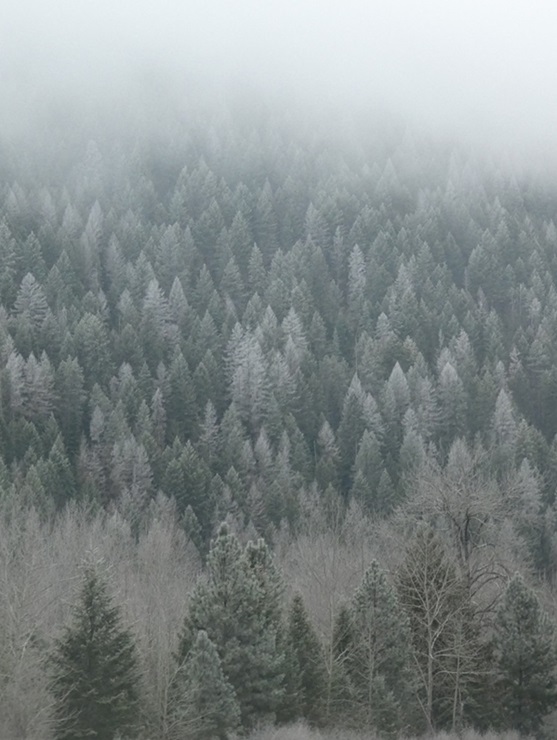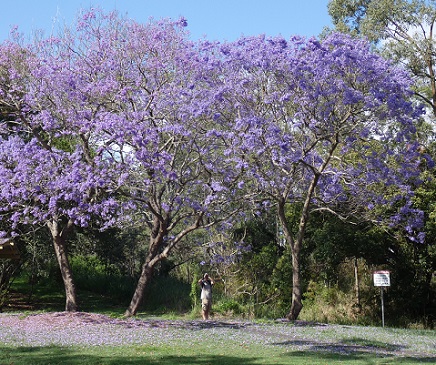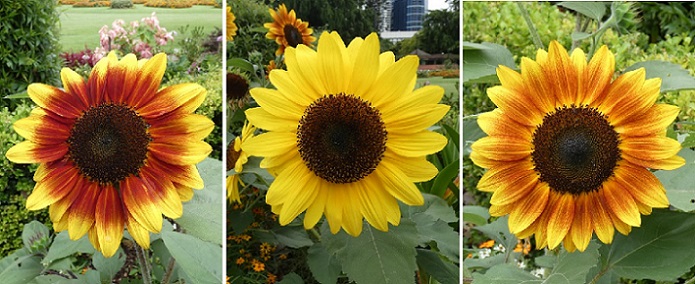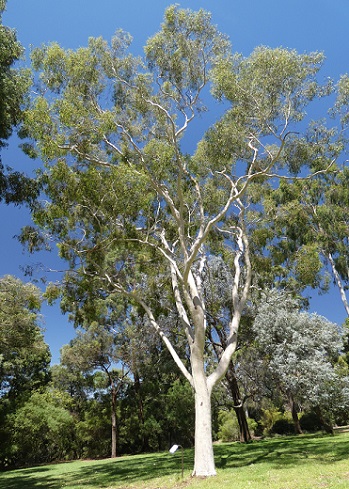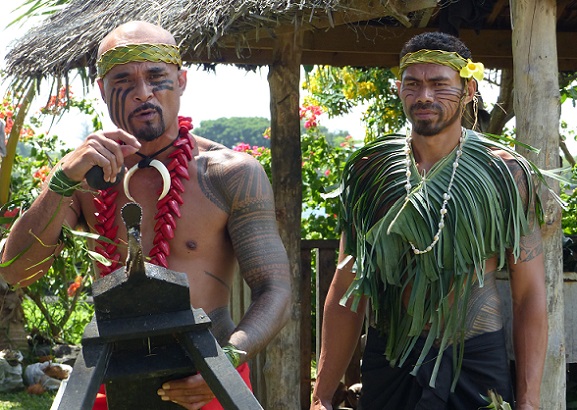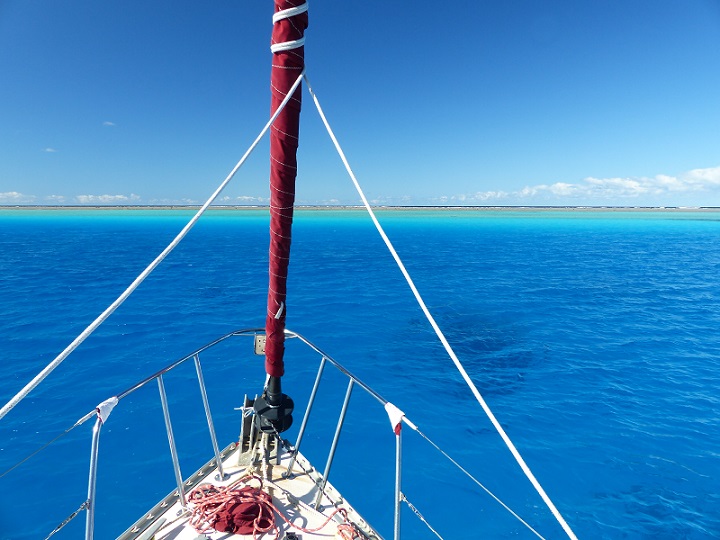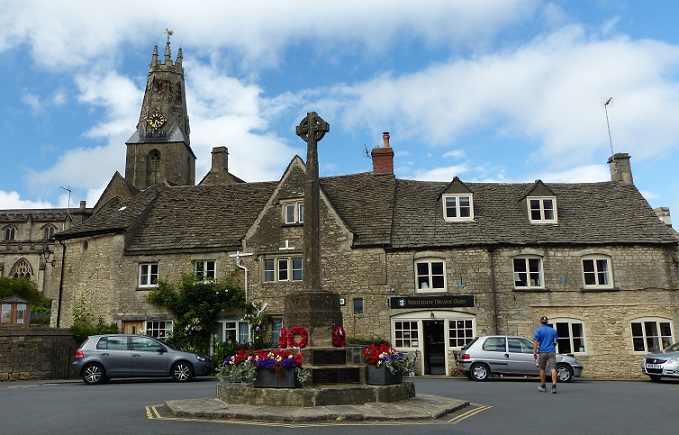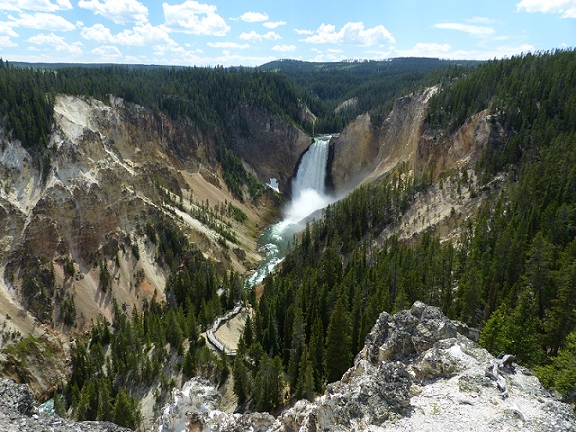
Tregoning
12 April 2024 | We are back aboard Tregoning in Mersin Marina, Mersin, Türkiye
02 April 2024 | We are in Toronto Airport, Canada: Tregoning is in Mersin Marina, Mersin, Türkiye
25 February 2024 | We are back in Gainesville, FL: Tregoning is in Mersin Marina, Mersin, Türkiye
18 February 2024 | We are in Glenwood, New Mexico: Tregoning is in Mersin Marina, Mersin, Türkiye
12 February 2024 | We are in Morro Bay, California: Tregoning is in Mersin Marina, Mersin, Türkiye
19 January 2024 | We are in Vancouver, BC Canada: Tregoning is in Mersin Marina, Mersin, Türkiye
01 January 2024 | We are in Washington State: Tregoning is in Mersin Marina, Mersin, Türkiye
15 December 2023 | We are in Minnesota: Tregoning is in Mersin Marina, Mersin, Türkiye
18 November 2023 | We are in Florida: Tregoning is in Mersin Marina, Mersin, Türkiye
29 October 2023 | We're in Florida - Tregoning is at B-dock, Mersin Marina, Mersin, Türkiye
21 October 2023 | 7 Oda Kapadokya Cave Hotel, Ürgüp, Türkiye
14 October 2023 | Hotel Aşikoğlu, Boğazkale, Türkiye
07 October 2023 | B-dock, Mersin Marina, Mersin, Türkiye
19 September 2023 | “Chez Jon & Angela”, Near Otterton, Devon, UK
14 September 2023 | Airbnb in Fortuneswell on the Isle of Portland, Dorset, UK
11 September 2023 | With Mike, Grange-over-Sands, Cumbria, UK
03 September 2023 | Ardington House, Ardington, Oxfordshire, UK
24 August 2023 | Near "Chez Joan and Peter", College of Roseisle, Moray, Scotland
11 August 2023 | Andrew's house (not exactly), Lichfield, UK
22 July 2023 | Chez Gail, near the New York Café, Budapest, Hungary
Gigantic trees
14 September 2016 | Tregoning is in Whangarei Town Basin Marina, Whangarei, New Zealand but we are in Fortuna, CA
Photo: Martha, Randall, and Court are dwarfed by giant sequoias in Calaveras Big Trees State Park
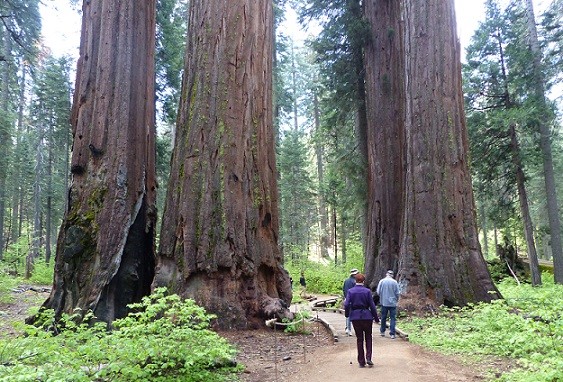
On returning to the USA, we were very fortunate to be able to spend 10 days in Olympia, WA, with Michael and Jan. Both Randall and I were so thankful to be able to charge-up our personal batteries while we were not rushing from house to house. We did not completely laze around while Jan and Michael went to work but we helped them get the house and yard ready for their big family reunion. We also joined them for some wine-tasting, some excellent dining, and a fabulous ukulele concert by Jake Shimabukuro.
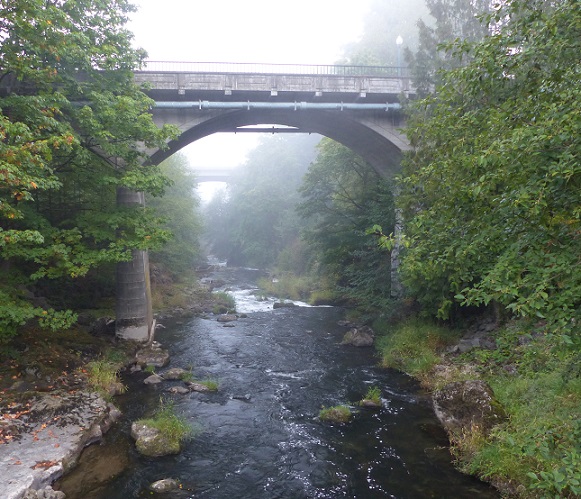
Mist over the Deschutes River
In addition to frequent visits to walk and run around the Maclane Creek Nature Trails in the neighboring Capitol State Forest, one morning we visited Tumwater Falls because we had heard that the salmon run had started in the Deschutes River. Indeed, we did see salmon both at the bottom of the lower falls, preparing to go up the fish ladder, and in the hatchery ponds at the top of the falls. There have been fish ladders around the three sets of falls on the river since 1952.
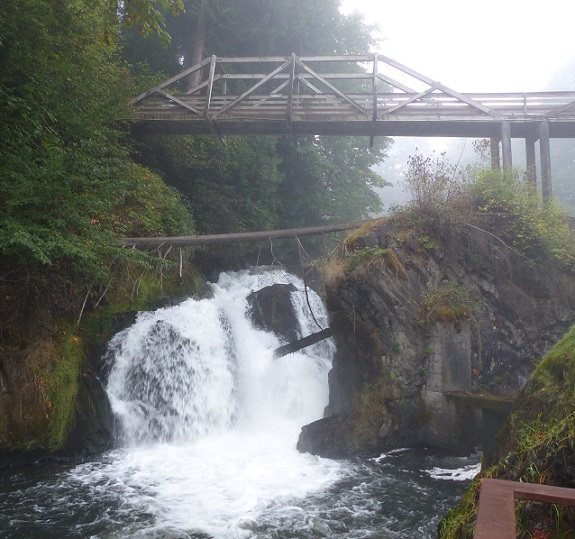
Lower Tumwater Falls with salmon ladder to right
Chinook and coho salmon caught in the hatchery are stripped of their eggs and semen which ar distributed to other hatcheries around Puget Sound for incubation and early rearing. In the spring, about 4 million smolt are returned to the Tumwater hatchery to imprint on the river water and then are released. All hatchery fish have the adipose fin clipped so that they can be identified when caught in recreational, commercial, or tribal fisheries, or if they return to the Deschutes River. In many fisheries, naturally spawned salmon must be released to return to their rivers of origin while hatchery-raised fish may be kept. Similarly, when adult fish return to the Deschutes River, only hatchery-raised fish will be captured while naturally spawned fish are allowed to continue upstream. Salmon die after they have spawned and the hatchery fish are put to good use including donations to food banks, placement in rivers as a natural way to return nutrients, and some commercial sales with the funds so raised supporting salmon enhancement programs around the state.
The salmon hatchery is not the only successful project that has been established on the river in Tumwater. In 1846, the first community of European settlers was founded by the falls on the river where it enters the southernmost bay of Puget Sound, at the end of the arduous Oregon Trail. Initially (and rather unimaginatively) named New Market, eventually the inhabitants adopted the Chinook name for the cataract, Tumwater, which refers to "throbbing water". Early settlers used the river at the falls to power saw mills, etc., then in the late 1800s, when steam combustion engines enabled sawmills to relocate closer to the forests, some hydropower was generated for urban and domestic use.
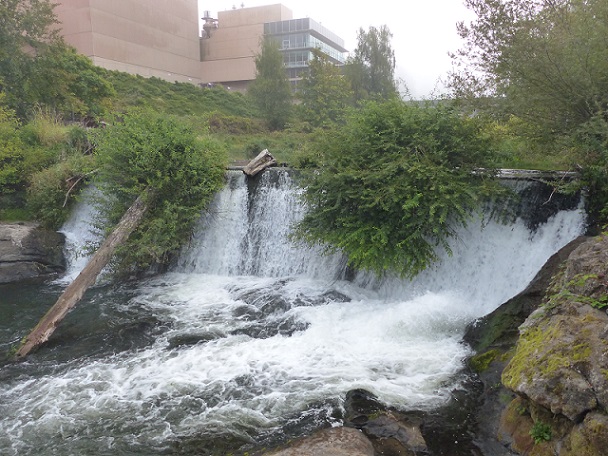
Upper Tumwater falls with empty buildings of the Olympia Brewery above
In 1896, a German immigrant started the successful Olympia Brewery. Although it was closed during Prohibition, it was reopened in 1934 at a modern facility upstream and became Tumwater's largest private employer for much of the 20th century. However, it finally closed in 2003 and the extensive buildings stand empty and forlorn, waiting to see what new industry or development might be able to take advantage of the riverside location.
Michael and Jan's family reunion went very well with a beautiful sunny day and more than 30 extended-family members (aged from a few months to quite a few decades) gathering to talk, eat, and drink. Assorted dogs were also in attendance and Jan kindly gave some of the children an opportunity to ride on one of her horses. The following day, many of us crammed onto Touchrain, Michael and Jan's beloved cruising boat, and we went out into Budd Inlet. It was the first sailing experience for grandson August, whose parents Alex and Ellie are keen, skilled, and competitive racing-dinghy sailors. Initially it was rather overcast but the sun finally emerged which made the views of Olympia much more attractive. There was only sufficient breeze to hoist their lightweight drifter sail briefly but it did not really matter, it was still wonderful to be afloat for a couple of hours.
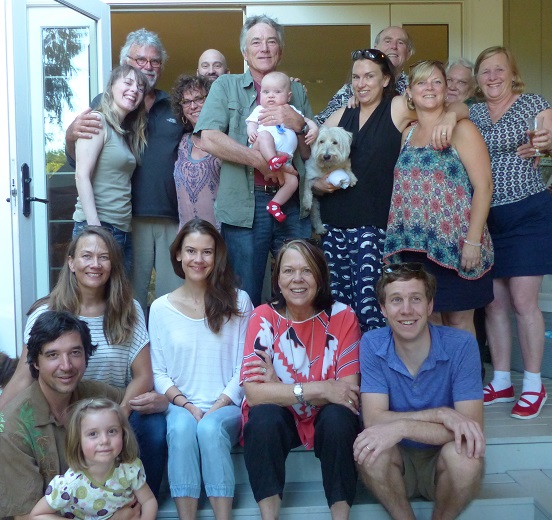
Part of Jan (far right) and Michael's (center holding baby grandson) family reunion
On leaving Olympia to start our long drive to California, we initially headed in the opposite direction because we were going to Seattle to spend a night with Brian. Needless to say, it was very strange to visit his house without the presence of Sarah and more than a few tears were shed. However, after our initial round of hugs and head-shaking in disbelief, Brian rallied and took us for a lovely walk around the sculpture park along the Seattle waterfront.
Dinner was an excellent vegetarian feast provided for us all at his house by two of Sarah's former graduate students. They were part of the online www.mealtrain.com organized by friends and colleagues so that every evening, somebody came over to provide Brian with food and company for which he was very grateful. He also had a fridge and kitchen counter overflowing with food.

View from Brian's deck after sunset looking over Puget Sound to the Olympic Mountains
After they left, Brian, Randall and I sat outside on the recently refurbished deck, enjoying the magnificent views over the Puget Sound. Slowly Brian described his incredible experience with Sarah's unexpected death while leading a botanical tour in South Africa and he expressed how grateful he was for the help that he received from the US Consulate General there. We were sorry that our visit had to be so brief but we also realized that Brian needed plenty of space as well as periods of company while he completely re-visualized his future.

Meyers Creek Beach, OR, with driftwood logs and isolated rocks characteristic of this coast
After taking Interstate 5 south, almost to the border with Oregon, we headed west and crossed the Columbia River in Astoria. The sunny weather gave us fabulous views along the Oregon coastline, however, we did not have much time to stop and sightsee. After spending a night in North Bend, just across the estuary from Coos Bay (where we had spent a few nights on Tregoning in 2013), we found ourselves passing numerous bicyclists who were participating in the Oregon Coast Ride. A thick "marine layer" of clouds and fog obliterated the sun for much of the morning so we stopped only for a quick walk on the beach at Meyers Creek Beach. The sky had cleared, however, by the time we reached Crescent City in California, so after eating our picnic lunch, we enjoyed another stroll on the coast overlooking the privately-owned Battery Point Lighthouse. Crescent City was badly damaged, and 12 people were killed, by a tsunami in 1964 so that rebuilt parts of the town now have a very 1960s look to them.
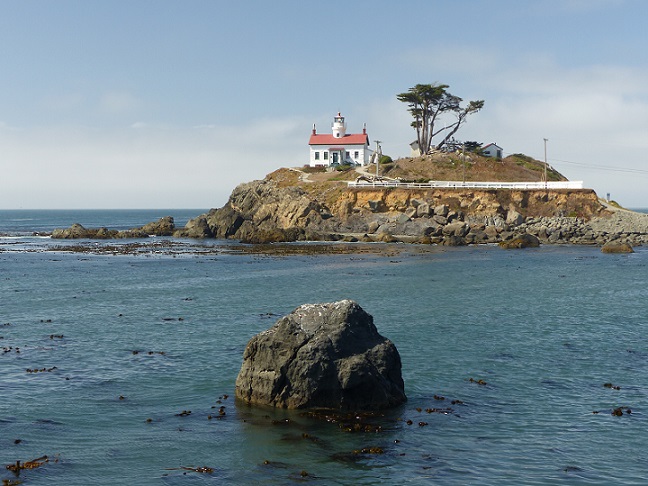
Battery Point Lighthouse

Behind Battery Point Lighthouse - a poor choice for an anchorage
There was plenty of historical information about the tsunami at the Visitors Center and there were also many maps and trail guides for Redwood National and State Parks. This was helpful because the Prairie Creek Redwoods State Park, south and inland of Crescent City, was to be our next stop for a walk among the giant coastal redwood trees. This was our third redwood park this summer, having visited John Muir Woods National Monument near San Francisco and Calaveras Big Trees State Park in the foothills of the Sierras in May.
The Sequoioideae (redwoods) is a subfamily in the family Cupressaceae (cypresses) which has three genera, each of which have only one living species. The Sequoia and Sequoiadendron genera occur in California and Oregon and include the largest and tallest trees in the world with individual trees that can live for thousands of years. The species within the third genus, Metasequoia, has smaller, deciduous trees that are a mere 200 feet (61 m) tall. These trees were so rare that they were thought to be extinct, until rediscovered by a forester in 1943 on mountainous slopes in remote parts of the Hubei region of China. While the native habitat is threatened with deforestation, specimens of Metasequoia glyptostroboides have been transplanted to botanical gardens all over the world and it has proved to be a popular and fast-growing ornamental plant.
The existing range of Sequoiadendron giganteum, the giant sequoia or giant redwood, is limited to 68 groves in the western slopes of the Sierra Nevada range of California, which cover 35,620 acres (142,480 ha). Prior to the last ice age, the species would have been quite common in coniferous forests across North American and Eurasia. Its current distribution includes the popular Mariposa Grove in the southern part of Yosemite National Park. Calaveras Big Trees State Park is about 35 miles (55 km) northwest of Yosemite and the giant sequoias dominate a forest that also includes ponderosa pines, sugar pines, incense cedars, white fir, and Pacific dogwoods.

A bench in a grove of young giant sequoias at Calaveras Big Trees State Park
Giant sequoias are evergreen trees that can reach a height of 311 feet (95 m), which is not as tall as the coastal redwoods, but with truck diameters at chest-height up to 29 feet (9 m) they are the most massive single trees on earth and the largest living thing by volume. With bark up to 35 inches thick (90 cm), giant sequoias are able to withstand most forest fires and several trees are as much as 2,000 years old (the oldest verified giant sequoia is more than 3,500 years old). Other fire adaptations include plentiful tannins, which help to heal wounds and cause the red color of the wood and bark, and cones that only open after heating so that the released seeds can germinate in the fire-cleared soil. The natural cycle of fires in giant sequoia forests is every 20 to 50 years and suppression of natural fires is one of the major treats to this species both because seeds are not released and competition from less-fire tolerant species is not curbed.
The roots of these huge trees are surprisingly shallow, typically penetrating no more than 4 feet (1.5 m) into the soil. However, with some roots up to 125 feet long (38 m), they create a broad network that intermeshes with the roots of other trees to create a fairly stable forest. When a mature tree does fall, there may be quite a bit of collateral damage to other trees but the light-gap so created allows quick germination and development of young sequoias and other, less-shade-tolerant species. Because the tannins in the wood deter attack by fungi and insects, decay is slow and fallen logs may remain for a very long time in the forest. These horizontal trunks can provide a good substrate for seedlings and these "mother logs" eventually give rise to a row of similarly aged trees.
In addition to the incredible volume of each tree, the deep red color of the wood and the resistance to rot and insect damage, made redwood lumber very useful. The local Miwok respected and made careful use of the giant sequoias while other native groups saw the trees as sacred and untouchable. European settlers, however, were not as restrained and respectful.
The giant trees at Calaveras were first seen by a non-native settler in the spring of 1852 by a hunter tracking a wounded grizzly bear. When he was finally able to convince others of what he had seen, the first tree he saw, subsequently named the Discovery Tree, became an early casualty, taking 5 men 22 days to cut down. The massive stump remains at the North Grove in Calaveras Big Trees State Park, which was finally protected in 1931.
Our visit to the Park in May was with Martha and Cousin Court. Amazingly, despite only being a month since her hip-replacement, Martha was able to walk around the 1.5 mile self-guided trail, albeit rather slowly. The North Grove has many named trees, e.g., Father-of-the-Forest, Three Graces, Abraham Lincoln, and the inevitable tree with an arch cut through the base that is big enough for a carriage or car to pass through. This Pioneer Cabin Tree (a.k.a. The Tunnel Tree), was considered to be one of the most famous trees in the nation, drawing thousands of visitors every year. Estimated to be more than 1,000 years old, it was 33 feet (10 m) in diameter but its top had been removed sometime before 1859.
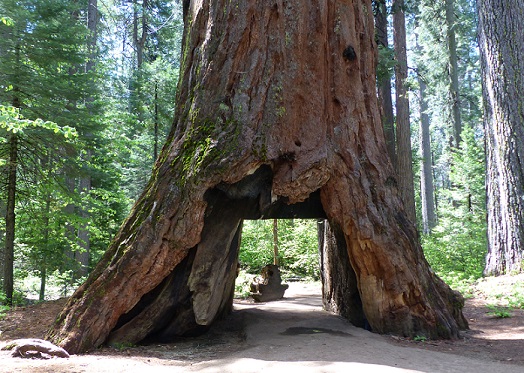
Pioneer Cabin Tree illustrating the red bark of giant sequoias in Calaveras Big Trees State Park
(Postscript note: Sadly, the tunnel probably reduced the stability of the trunk because the Pioneer Cabin Tree fell and shattered during a storm on January 8, 2017.)
The giant sequoias were not the only redwoods that were coveted for their lumber. Of the 2,100,000 acres (840,000 ha) of native coast redwood, Sequoia sempervirens, forest that occurred only in Northern California and several miles into Oregon in 1850, by 1968 only about 10% of never-logged forest remained. Fortunately, 38,982 acres (15,592 ha) of this old-growth forest is preserved in the Redwood National and State Parks.
Coast redwoods need plenty of moisture and so flourish in the fog-belt of coastal Northern California and southern Oregon. They have likely existed in this area for 20 million years and individual trees can live to 2,200 years old. Coast Redwoods are the tallest living things in the world, with the record-holder measured in 2006 at 379 feet (115 m). Although record-breaking coast redwoods may be as large at chest-height diameter as giant sequoias, up to a 29 feet (9 m) including 12-inch-thick bark (30 cm), in general this species is taller but more slender and less massive than the giant sequoias.
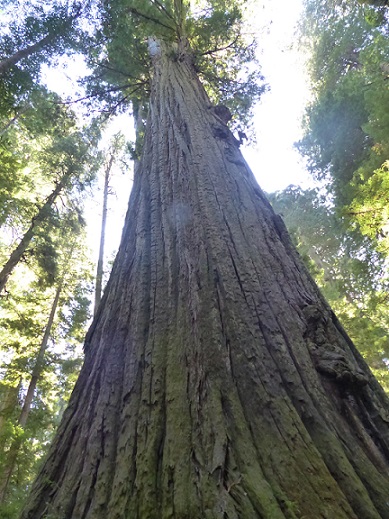
Looking up the trunk of a coast redwood in Prairie Creek Redwoods State Park
At 100 feet long (30 m), the roots of the coast redwoods are shorter than those of the giant sequoias but they penetrate further into the moist soils, up to 10 to 13 feet (3 to 4 m) deep. Most reproduction in established forests is by shoots sprouting from burls, which are a mass of dormant buds at the tree's base, on its roots, or on the side of the trunk. Sprouting at the base of a stump can form a family circle of trees that remains distinctive long after the parent tree has fallen and decomposed.
Perhaps the most popular place for people to see the coast redwoods is at the John Muir Woods National Monument, which is part of the Golden Gate International Biosphere Reserve north of San Francisco. This rather inaccessible land along a steeply sided valley was the last parcel of redwood forest in the Bay area that had not been logged and so was purchased by a local US congressman and his wife to save it from logging. When a water company threatened to flood the valley, the couple donated it to the federal government for protection as a National Monument established by President Theodore Roosevelt in 1908. Rather than being named for the donors, Mr. and Mrs. Kent, they requested that it be named in honor of conservationist John Muir. During our brief visit to this park in May, on our way to meet Jan and Michael in the Napa Valley, we followed the 2-mile loop walk up and down Redwood Creek and enjoyed a picnic by a stream in the adjoining Mount Tamalpais State Park.
With the aid of short-line railroads and steam donkeys (engines that hauled the massive trunks through the woods), by the early 1900s logging of coast redwoods in the more northerly parts of California had also devastated thousands of acres of old-growth forest. The coastal town of Eureka alone had nine sawmills. By 1923, the State of California with the financial support of the Save the Redwood League (established in 1918) was able to acquire some of the grandest old-growth tree stands in the world, which are preserved in four State Parks co-managed with the National Park Service. One of these is Prairie Creek Redwoods State Park and here we enjoyed a rigorous walk through the forest along a 3-mile loop trail.

People (bottom center) dwarfed by coast redwoods along the trail in Prairie Creek Redwoods State Park
In this part of California, the Yurok people had thrived for centuries with villages constructed from redwood planks along major waterways. However, they were quickly displaced after gold was found near Fern Canyon (on the coastal edge of the present Prairie Creek State Park) in 1850. Despite such displacement and the exposure to European diseases, these people have made a remarkable recovery and now constitute the most populous tribe in California with nearly 5,500 Yurok living in the area.
At the end of our afternoon's hike and drive through the grand redwood forests, we stayed in a hotel in Fortuna. The following morning we completed our trip to San Jose where we were very happy to find Martha walking effortlessly and confidently, without any signs of a limp. It was an almost miraculous change from the painful, hobbling state in which we had found her during our brief meeting in San Francisco airport at the beginning of the year.

Mist over the Deschutes River
In addition to frequent visits to walk and run around the Maclane Creek Nature Trails in the neighboring Capitol State Forest, one morning we visited Tumwater Falls because we had heard that the salmon run had started in the Deschutes River. Indeed, we did see salmon both at the bottom of the lower falls, preparing to go up the fish ladder, and in the hatchery ponds at the top of the falls. There have been fish ladders around the three sets of falls on the river since 1952.

Lower Tumwater Falls with salmon ladder to right
Chinook and coho salmon caught in the hatchery are stripped of their eggs and semen which ar distributed to other hatcheries around Puget Sound for incubation and early rearing. In the spring, about 4 million smolt are returned to the Tumwater hatchery to imprint on the river water and then are released. All hatchery fish have the adipose fin clipped so that they can be identified when caught in recreational, commercial, or tribal fisheries, or if they return to the Deschutes River. In many fisheries, naturally spawned salmon must be released to return to their rivers of origin while hatchery-raised fish may be kept. Similarly, when adult fish return to the Deschutes River, only hatchery-raised fish will be captured while naturally spawned fish are allowed to continue upstream. Salmon die after they have spawned and the hatchery fish are put to good use including donations to food banks, placement in rivers as a natural way to return nutrients, and some commercial sales with the funds so raised supporting salmon enhancement programs around the state.
The salmon hatchery is not the only successful project that has been established on the river in Tumwater. In 1846, the first community of European settlers was founded by the falls on the river where it enters the southernmost bay of Puget Sound, at the end of the arduous Oregon Trail. Initially (and rather unimaginatively) named New Market, eventually the inhabitants adopted the Chinook name for the cataract, Tumwater, which refers to "throbbing water". Early settlers used the river at the falls to power saw mills, etc., then in the late 1800s, when steam combustion engines enabled sawmills to relocate closer to the forests, some hydropower was generated for urban and domestic use.

Upper Tumwater falls with empty buildings of the Olympia Brewery above
In 1896, a German immigrant started the successful Olympia Brewery. Although it was closed during Prohibition, it was reopened in 1934 at a modern facility upstream and became Tumwater's largest private employer for much of the 20th century. However, it finally closed in 2003 and the extensive buildings stand empty and forlorn, waiting to see what new industry or development might be able to take advantage of the riverside location.
Michael and Jan's family reunion went very well with a beautiful sunny day and more than 30 extended-family members (aged from a few months to quite a few decades) gathering to talk, eat, and drink. Assorted dogs were also in attendance and Jan kindly gave some of the children an opportunity to ride on one of her horses. The following day, many of us crammed onto Touchrain, Michael and Jan's beloved cruising boat, and we went out into Budd Inlet. It was the first sailing experience for grandson August, whose parents Alex and Ellie are keen, skilled, and competitive racing-dinghy sailors. Initially it was rather overcast but the sun finally emerged which made the views of Olympia much more attractive. There was only sufficient breeze to hoist their lightweight drifter sail briefly but it did not really matter, it was still wonderful to be afloat for a couple of hours.

Part of Jan (far right) and Michael's (center holding baby grandson) family reunion
On leaving Olympia to start our long drive to California, we initially headed in the opposite direction because we were going to Seattle to spend a night with Brian. Needless to say, it was very strange to visit his house without the presence of Sarah and more than a few tears were shed. However, after our initial round of hugs and head-shaking in disbelief, Brian rallied and took us for a lovely walk around the sculpture park along the Seattle waterfront.
Dinner was an excellent vegetarian feast provided for us all at his house by two of Sarah's former graduate students. They were part of the online www.mealtrain.com organized by friends and colleagues so that every evening, somebody came over to provide Brian with food and company for which he was very grateful. He also had a fridge and kitchen counter overflowing with food.

View from Brian's deck after sunset looking over Puget Sound to the Olympic Mountains
After they left, Brian, Randall and I sat outside on the recently refurbished deck, enjoying the magnificent views over the Puget Sound. Slowly Brian described his incredible experience with Sarah's unexpected death while leading a botanical tour in South Africa and he expressed how grateful he was for the help that he received from the US Consulate General there. We were sorry that our visit had to be so brief but we also realized that Brian needed plenty of space as well as periods of company while he completely re-visualized his future.

Meyers Creek Beach, OR, with driftwood logs and isolated rocks characteristic of this coast
After taking Interstate 5 south, almost to the border with Oregon, we headed west and crossed the Columbia River in Astoria. The sunny weather gave us fabulous views along the Oregon coastline, however, we did not have much time to stop and sightsee. After spending a night in North Bend, just across the estuary from Coos Bay (where we had spent a few nights on Tregoning in 2013), we found ourselves passing numerous bicyclists who were participating in the Oregon Coast Ride. A thick "marine layer" of clouds and fog obliterated the sun for much of the morning so we stopped only for a quick walk on the beach at Meyers Creek Beach. The sky had cleared, however, by the time we reached Crescent City in California, so after eating our picnic lunch, we enjoyed another stroll on the coast overlooking the privately-owned Battery Point Lighthouse. Crescent City was badly damaged, and 12 people were killed, by a tsunami in 1964 so that rebuilt parts of the town now have a very 1960s look to them.

Battery Point Lighthouse

Behind Battery Point Lighthouse - a poor choice for an anchorage
There was plenty of historical information about the tsunami at the Visitors Center and there were also many maps and trail guides for Redwood National and State Parks. This was helpful because the Prairie Creek Redwoods State Park, south and inland of Crescent City, was to be our next stop for a walk among the giant coastal redwood trees. This was our third redwood park this summer, having visited John Muir Woods National Monument near San Francisco and Calaveras Big Trees State Park in the foothills of the Sierras in May.
The Sequoioideae (redwoods) is a subfamily in the family Cupressaceae (cypresses) which has three genera, each of which have only one living species. The Sequoia and Sequoiadendron genera occur in California and Oregon and include the largest and tallest trees in the world with individual trees that can live for thousands of years. The species within the third genus, Metasequoia, has smaller, deciduous trees that are a mere 200 feet (61 m) tall. These trees were so rare that they were thought to be extinct, until rediscovered by a forester in 1943 on mountainous slopes in remote parts of the Hubei region of China. While the native habitat is threatened with deforestation, specimens of Metasequoia glyptostroboides have been transplanted to botanical gardens all over the world and it has proved to be a popular and fast-growing ornamental plant.
The existing range of Sequoiadendron giganteum, the giant sequoia or giant redwood, is limited to 68 groves in the western slopes of the Sierra Nevada range of California, which cover 35,620 acres (142,480 ha). Prior to the last ice age, the species would have been quite common in coniferous forests across North American and Eurasia. Its current distribution includes the popular Mariposa Grove in the southern part of Yosemite National Park. Calaveras Big Trees State Park is about 35 miles (55 km) northwest of Yosemite and the giant sequoias dominate a forest that also includes ponderosa pines, sugar pines, incense cedars, white fir, and Pacific dogwoods.

A bench in a grove of young giant sequoias at Calaveras Big Trees State Park
Giant sequoias are evergreen trees that can reach a height of 311 feet (95 m), which is not as tall as the coastal redwoods, but with truck diameters at chest-height up to 29 feet (9 m) they are the most massive single trees on earth and the largest living thing by volume. With bark up to 35 inches thick (90 cm), giant sequoias are able to withstand most forest fires and several trees are as much as 2,000 years old (the oldest verified giant sequoia is more than 3,500 years old). Other fire adaptations include plentiful tannins, which help to heal wounds and cause the red color of the wood and bark, and cones that only open after heating so that the released seeds can germinate in the fire-cleared soil. The natural cycle of fires in giant sequoia forests is every 20 to 50 years and suppression of natural fires is one of the major treats to this species both because seeds are not released and competition from less-fire tolerant species is not curbed.
The roots of these huge trees are surprisingly shallow, typically penetrating no more than 4 feet (1.5 m) into the soil. However, with some roots up to 125 feet long (38 m), they create a broad network that intermeshes with the roots of other trees to create a fairly stable forest. When a mature tree does fall, there may be quite a bit of collateral damage to other trees but the light-gap so created allows quick germination and development of young sequoias and other, less-shade-tolerant species. Because the tannins in the wood deter attack by fungi and insects, decay is slow and fallen logs may remain for a very long time in the forest. These horizontal trunks can provide a good substrate for seedlings and these "mother logs" eventually give rise to a row of similarly aged trees.
In addition to the incredible volume of each tree, the deep red color of the wood and the resistance to rot and insect damage, made redwood lumber very useful. The local Miwok respected and made careful use of the giant sequoias while other native groups saw the trees as sacred and untouchable. European settlers, however, were not as restrained and respectful.
The giant trees at Calaveras were first seen by a non-native settler in the spring of 1852 by a hunter tracking a wounded grizzly bear. When he was finally able to convince others of what he had seen, the first tree he saw, subsequently named the Discovery Tree, became an early casualty, taking 5 men 22 days to cut down. The massive stump remains at the North Grove in Calaveras Big Trees State Park, which was finally protected in 1931.
Our visit to the Park in May was with Martha and Cousin Court. Amazingly, despite only being a month since her hip-replacement, Martha was able to walk around the 1.5 mile self-guided trail, albeit rather slowly. The North Grove has many named trees, e.g., Father-of-the-Forest, Three Graces, Abraham Lincoln, and the inevitable tree with an arch cut through the base that is big enough for a carriage or car to pass through. This Pioneer Cabin Tree (a.k.a. The Tunnel Tree), was considered to be one of the most famous trees in the nation, drawing thousands of visitors every year. Estimated to be more than 1,000 years old, it was 33 feet (10 m) in diameter but its top had been removed sometime before 1859.

Pioneer Cabin Tree illustrating the red bark of giant sequoias in Calaveras Big Trees State Park
(Postscript note: Sadly, the tunnel probably reduced the stability of the trunk because the Pioneer Cabin Tree fell and shattered during a storm on January 8, 2017.)
The giant sequoias were not the only redwoods that were coveted for their lumber. Of the 2,100,000 acres (840,000 ha) of native coast redwood, Sequoia sempervirens, forest that occurred only in Northern California and several miles into Oregon in 1850, by 1968 only about 10% of never-logged forest remained. Fortunately, 38,982 acres (15,592 ha) of this old-growth forest is preserved in the Redwood National and State Parks.
Coast redwoods need plenty of moisture and so flourish in the fog-belt of coastal Northern California and southern Oregon. They have likely existed in this area for 20 million years and individual trees can live to 2,200 years old. Coast Redwoods are the tallest living things in the world, with the record-holder measured in 2006 at 379 feet (115 m). Although record-breaking coast redwoods may be as large at chest-height diameter as giant sequoias, up to a 29 feet (9 m) including 12-inch-thick bark (30 cm), in general this species is taller but more slender and less massive than the giant sequoias.

Looking up the trunk of a coast redwood in Prairie Creek Redwoods State Park
At 100 feet long (30 m), the roots of the coast redwoods are shorter than those of the giant sequoias but they penetrate further into the moist soils, up to 10 to 13 feet (3 to 4 m) deep. Most reproduction in established forests is by shoots sprouting from burls, which are a mass of dormant buds at the tree's base, on its roots, or on the side of the trunk. Sprouting at the base of a stump can form a family circle of trees that remains distinctive long after the parent tree has fallen and decomposed.
Perhaps the most popular place for people to see the coast redwoods is at the John Muir Woods National Monument, which is part of the Golden Gate International Biosphere Reserve north of San Francisco. This rather inaccessible land along a steeply sided valley was the last parcel of redwood forest in the Bay area that had not been logged and so was purchased by a local US congressman and his wife to save it from logging. When a water company threatened to flood the valley, the couple donated it to the federal government for protection as a National Monument established by President Theodore Roosevelt in 1908. Rather than being named for the donors, Mr. and Mrs. Kent, they requested that it be named in honor of conservationist John Muir. During our brief visit to this park in May, on our way to meet Jan and Michael in the Napa Valley, we followed the 2-mile loop walk up and down Redwood Creek and enjoyed a picnic by a stream in the adjoining Mount Tamalpais State Park.
With the aid of short-line railroads and steam donkeys (engines that hauled the massive trunks through the woods), by the early 1900s logging of coast redwoods in the more northerly parts of California had also devastated thousands of acres of old-growth forest. The coastal town of Eureka alone had nine sawmills. By 1923, the State of California with the financial support of the Save the Redwood League (established in 1918) was able to acquire some of the grandest old-growth tree stands in the world, which are preserved in four State Parks co-managed with the National Park Service. One of these is Prairie Creek Redwoods State Park and here we enjoyed a rigorous walk through the forest along a 3-mile loop trail.

People (bottom center) dwarfed by coast redwoods along the trail in Prairie Creek Redwoods State Park
In this part of California, the Yurok people had thrived for centuries with villages constructed from redwood planks along major waterways. However, they were quickly displaced after gold was found near Fern Canyon (on the coastal edge of the present Prairie Creek State Park) in 1850. Despite such displacement and the exposure to European diseases, these people have made a remarkable recovery and now constitute the most populous tribe in California with nearly 5,500 Yurok living in the area.
At the end of our afternoon's hike and drive through the grand redwood forests, we stayed in a hotel in Fortuna. The following morning we completed our trip to San Jose where we were very happy to find Martha walking effortlessly and confidently, without any signs of a limp. It was an almost miraculous change from the painful, hobbling state in which we had found her during our brief meeting in San Francisco airport at the beginning of the year.
Comments
| Vessel Name: | Tregoning |
| Vessel Make/Model: | Morgan Classic 41 |
| Hailing Port: | Gainesville, FL |
| Crew: | Alison and Randall |
| About: | We cast-off from Fernandina Beach in north Florida on 1st June 2008 and we have been cruising on Tregoning ever since. Before buying Tregoning, both of us had been sailing on smaller boats for many years and had worked around boats and water throughout our careers. |
| Extra: | “Tregoning” (rhymes with “belonging”) and is a Cornish word (meaning “homestead of Cohnan” or “farm by the ash trees”) and was Alison's mother’s middle name. Cornwall is in southwest England and is where Alison grew-up. |
Tregoning's Photos - Main
 |
Extra photographs from our three-week campervan tour of the South Island from November 15th to December 5th 2015
217 Photos
Created 4 January 2016
|
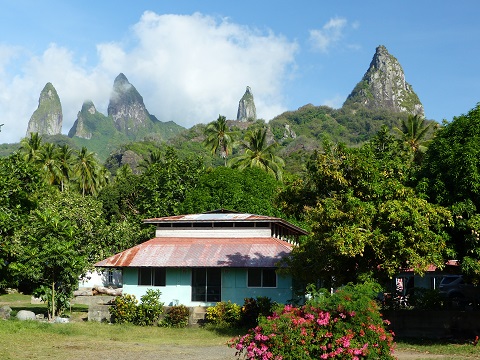 |
Random pictures from our month spent on the islands of Hiva Oa, Tahuata, Ua Pou, and Nuku Hiva
45 Photos
Created 18 July 2015
|
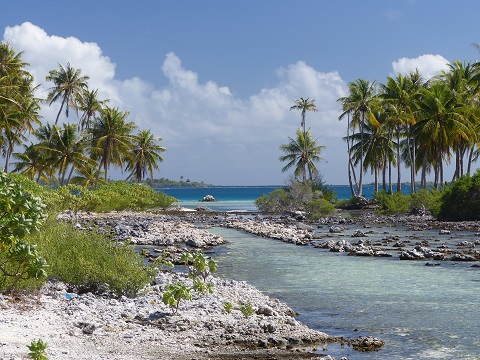 |
Random pictures from our month spent in 4 Tuamotu Atolls; Ahe, Fakarava, Tahanea, and Toau
32 Photos
Created 1 July 2015
|
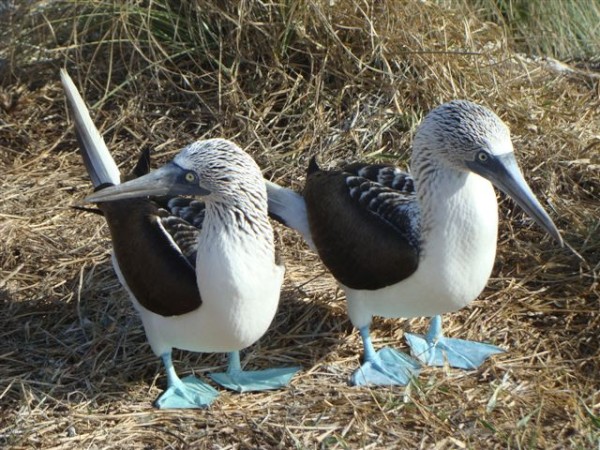 |
Some of the birds, fish, reptiles, and mammals (and others) that we have seen in Mexico
74 Photos
Created 5 May 2014
|
Tregoning

Who: Alison and Randall
Port: Gainesville, FL
